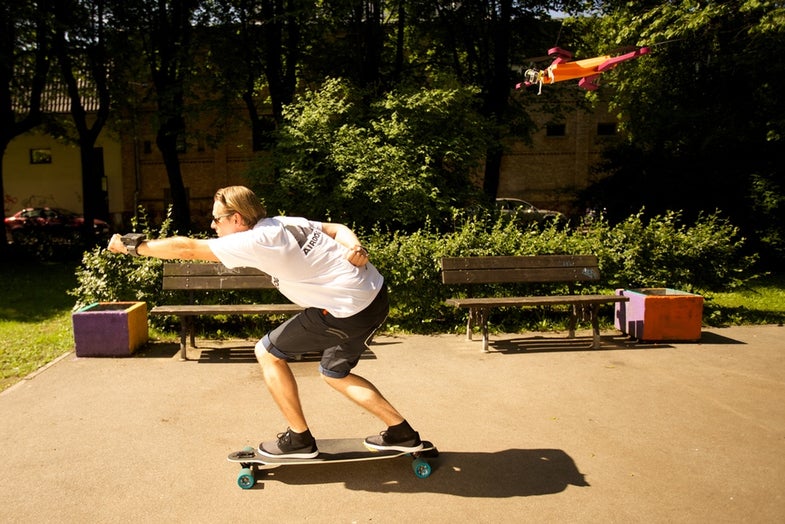Kickstarter: AirDog and Hexo+ GoPro Mounted, Tracking Drones
Two Kickstarters want to use drones to keep your GoPro tracking your action

Today we heard word of two Kickstarters that aim to do something very similar. The AirDog and Hexo+ are both flying drones what will house your GoPro, and keep it following you as you race down a track, through white water rapids, or pull tricks at the skate park—though the two drones offer some major differences.
The AirDog is arguably the more full-featured of the pair. Available for $1200 for backers, the AirDog is a quadcopter with a two-axis gyro stabilized gimbal to hold your GoPro. For the system to track you, it relies on a special water-proof wrist device that the AirDog will home in on, and stay facing. This AirLeash will keep the AirDog pointed at you, let you control it, enables a 300m tracking distance, and warns you when it’s running low on its 10-20 minute battery life. Perhaps the most impressive feat of the AirDog is the variety of ways it can track you as you move. Here’s some of what it can do:
- Auto-follow. Will work with almost any sports. In this mode AirDog will follow you repeating exactly your movement trajectory while maintaining its position in preset distance and altitude from you.
- Relative position – In this mode AirDog will maintain constant offset relative to magnetic north from the rider. For example, you can set it to keep a 10 meter distance at 4 meters high to the east from your position. Even when you change your direction, the AirDog will stay at the same preset angle from you. We suggest this mode for straight line wakeboard cable parks, surfing, and some other sports.
- Follow track. This is the safest way to operate AirDog. Simply go for one lap with AirLeash and it will record your track. Then adjust AirDogs trajectory to your liking in smartphone app. AirDog will repeatedly fly over the exact set trajectory and the camera will be continually adjusted to aim at the rider.This is the most creative mode where you can become a true director of your movie. Adjust AirDog’s trajectory to avoid obstacles like buildings or trees. You can even make it to shoot you from different angle on different spots/kickers in the track. It might sound complicated, but its a simple few tap process in AirDog smartphone app.
- Hover and Aim. The Hover and Aim setting allows AirDog to stay in one position above the ground, but constantly directing the camera at the AirLeash. This setting is perfect for tight places such as smaller skateparks, narrow forest trails, or for activities such as bungee jumping or base jumping, where clearance from equipment is important.
- Circle. In this setting, AirDog makes circular rotations on a set radius and altitude, keeping the camera aimed at the AirLeash. This for slow speed or static shots to show impressive view around you.
- Look down. The most simple mode but can produce very stunning reasults. Simply “walk” your AirDog above a ramp or kicker where you are about to throw some epic tricks and with push of a button it will freeze its position and aim camera straight down. Now make sure you don’t go too high.

The Hexo+, on the other hand, is a smaller, more affordable, hexacopter. Backers can get on board for $600 (or 3D print their own for even less), and the Hexo+ will lock on to your smartphone rather than requiring an extra bit of hardware like the AirDog does. The advantage to this is that you already have a smartphone, but the downside is that smartphone connections tend to be fairly short distance, and you might not want to take your Droid barreling down the side of a cliff with you. The Hexo+ will feature a 15 minute flight time, and will be limited to 50 meter range (the AirDog will hit 300 meters).
Between these two Kickstarters, it’s obvious that self-tracking drones are rapidly becoming a thing. If these deliver on their promise, it’ll be possible to have your own private ‘copter, tracking your action, without the need for a trained operator to follow you from the sidelines. While battery life is still a problem (and that’s amidst all drones), these both point to an interesting possible future.